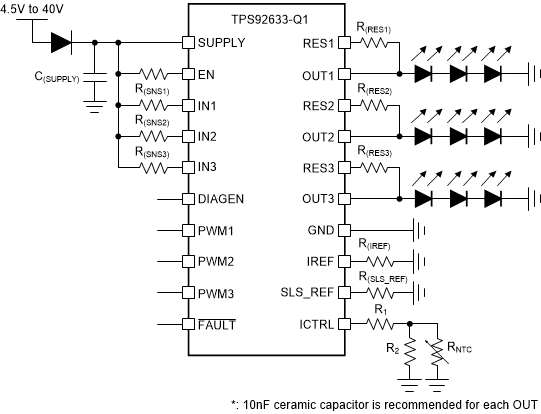SLVSF65A December 2020 – May 2021 TPS92633-Q1
PRODUCTION DATA
- 1 Features
- 2 Applications
- 3 Description
- 4 Revision History
- 5 Pin Configuration and Functions
- 6 Specifications
-
7 Detailed Description
- 7.1 Overview
- 7.2 Functional Block Diagram
- 7.3
Feature Description
- 7.3.1 Power Supply (SUPPLY)
- 7.3.2 Enable and Shutdown (EN)
- 7.3.3 Reference Current (IREF)
- 7.3.4 Constant-Current Output and Setting (INx)
- 7.3.5 Analog Current Control (ICTRL)
- 7.3.6 Thermal Sharing Resistor (OUTx and RESx)
- 7.3.7 PWM Control (PWMx)
- 7.3.8 Supply Control
- 7.3.9
Diagnostics
- 7.3.9.1 IREF Short-to-GND Detection
- 7.3.9.2 IREF Open Detection
- 7.3.9.3 LED Short-to-GND Detection
- 7.3.9.4 LED Open-Circuit Detection
- 7.3.9.5 Single LED Short-Circuit Detection (SLS_REF)
- 7.3.9.6 LED Open-Circuit and Single LED Short-Circuit Detection Enable (DIAGEN)
- 7.3.9.7 Low Dropout Operation
- 7.3.9.8 Over-Temperature Protection
- 7.3.10 FAULT Bus Output With One-Fails–All-Fail
- 7.3.11 FAULT Table
- 7.3.12 LED Fault Summary
- 7.3.13 IO Pins Inner Connection
- 7.4 Device Functional Modes
- 8 Application and Implementation
- 9 Power Supply Recommendations
- 10Layout
- 11Device and Documentation Support
- 12Mechanical, Packaging, and Orderable Information
7.3.5.2 NTC Resistor
The analog current control feature also allows to connect a NTC thermistor on ICTRL pin to achieve the LED current derating based on measured PCB board temperature or LED unit temperature. The resistance of NTC thermistor depends on the environment temperature. The resistance of NTC thermistor is decreasing with the temperature rising. It leads to the decreasing of the equivalent resistance of R(ICTRL) on ICTRL pin and the output current reduction from the calculation based on Equation 2 and Equation 3.
TI recommends to connect a resistor network including NTC thermistor (e.g. NCU18XH103F6SRB) to ICTRL pin as illustrated in below Figure 7-2. The resistor value of R1 and R2 work with NTC thermistor to adjust the equivalent resistance curve depending on the temperature to achieve the system required current derating.
 Figure 7-2 Application
Schematic For External NTC Thermistor
Figure 7-2 Application
Schematic For External NTC Thermistor